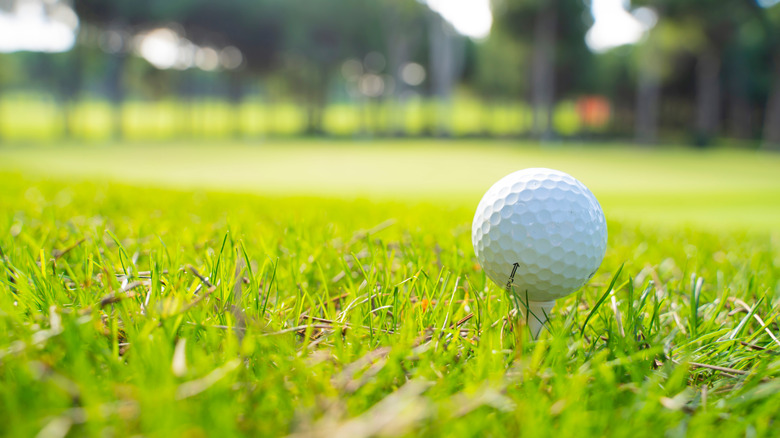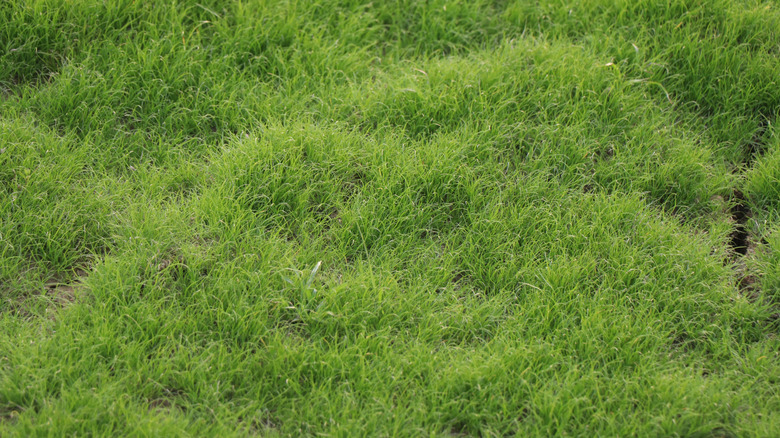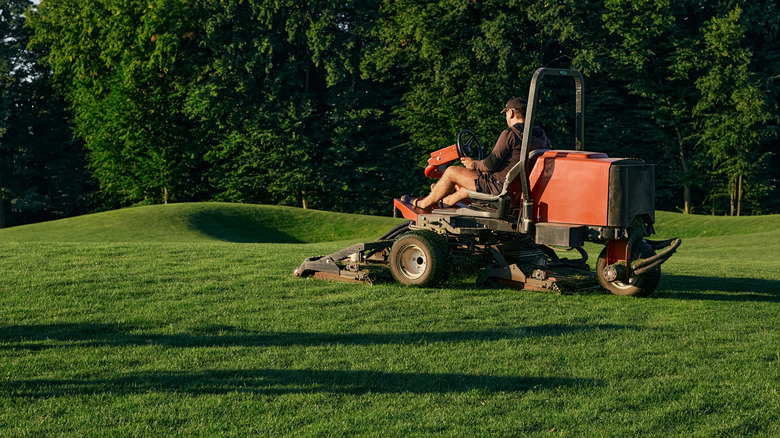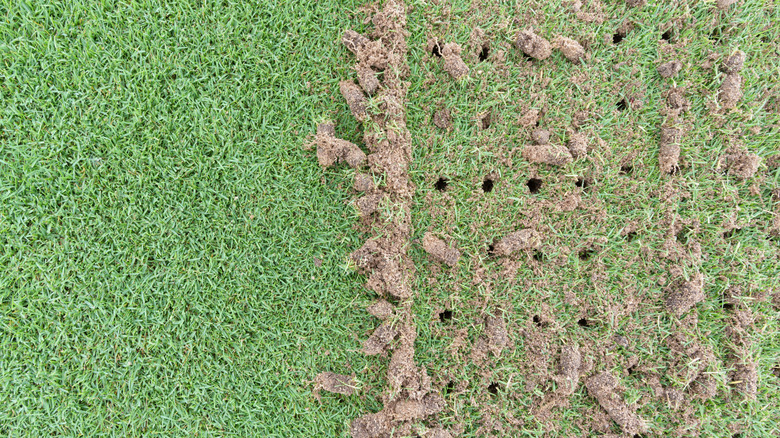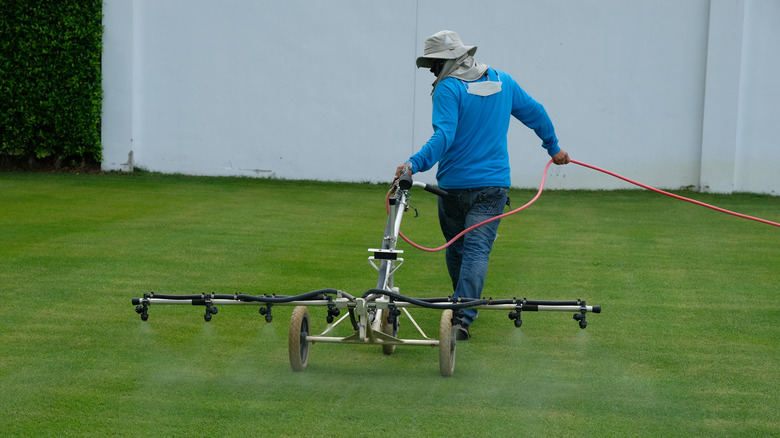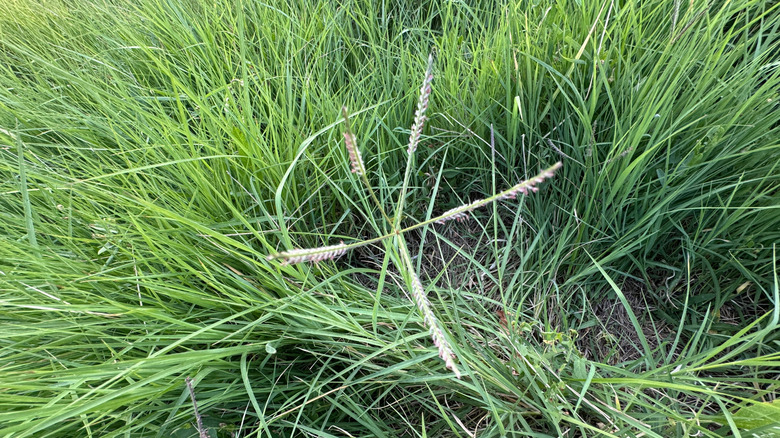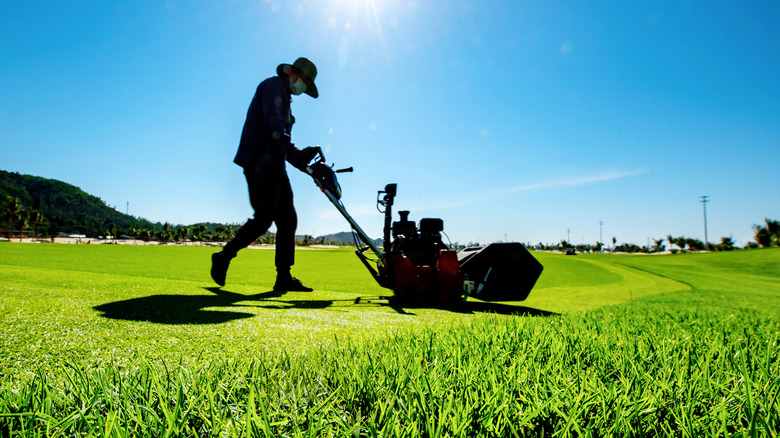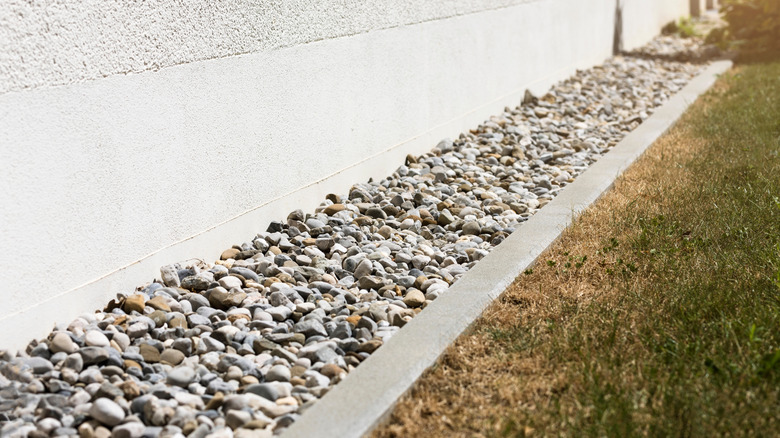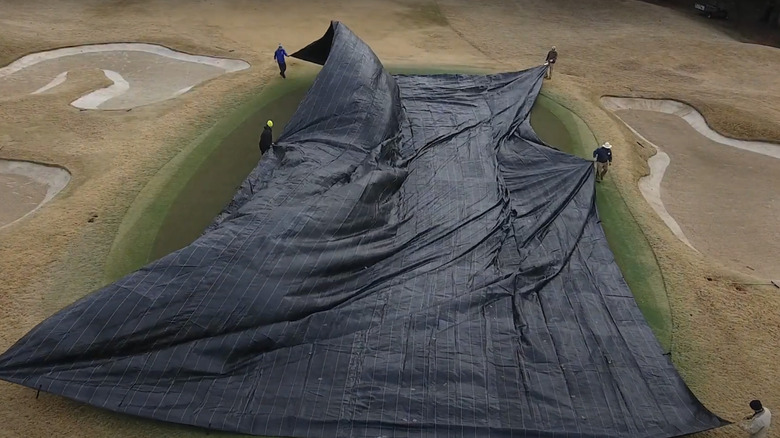11 Hacks To Steal From Golf Courses For A Better Lawn
We may receive a commission on purchases made from links.
Have you ever wondered how putting greens look so good? Their lush color even in the winter, the lack of brown spots, pests, and fungus — there is no secret sauce per se. Instead, it's a combination of meticulous care, lots of mowing, and let's be honest: A water bill that's pretty high. While you don't have to spend millions keeping your yard irrigated or every waking moment trimming each blade of grass, there is still a lot you can learn from the pros to keep your lawn looking like it's ready for the Masters.
For example, just choosing a different grass can make a big difference. So maybe you should reconsider growing St. Augustine Grass for a lusher look. There are also steps you might have been skipping during your lawn care days, like aerating and topdressing — a special technique that the greenskeepers have allegedly been using since the 1700s, but which many home gardeners and turf tenders have yet to try. Here are all the best hacks and insider techniques you'll want to steal from golf courses for a better lawn.
Pick the right kind of grass
Golf courses don't just have average grass on their fields. This is why they always look so green, thick, and lush. And it's not a one-size-fits-all sort of situation, as different grasses do better in different climates, so the courses must adjust what they have based on this. For example, Augusta National in Georgia uses bentgrass greens. It is a cool season grass that's very fine in texture, so you can mow it nice and short. It also spreads through above-ground stems called stolons, which makes it mimic astroturf. Kentucky bluegrass is another option that is less expensive to maintain, so you'll also find it on a lot of courses throughout the country.
The easiest way to discover what golf course grass is best suited to your local climate is to discover what your local courses are using. Country clubs, universities, and even public parks often have putting greens, and staff there may be able to tell you which types perform well in the area. Look for grass that handles your region's temperature extremes, rainfall patterns, and common pests. You can also consult local agricultural extension offices or turfgrass specialists. They often offer region-specific advice and may even conduct soil tests to help you choose the ideal grass variety for your own lawn.
Keep close tabs on your lawn's water requirements
Golf courses use A LOT of water (billions of gallons per day in the US if you combine them altogether). That's one reason why they are so green all the time. But simply irrigating your lawn more is not the secret to a fairway-like front yard. Golf course irrigation is highly precise, and many greenskeepers agree that one of the biggest mistakes people make caring for their home lawns is overwatering. "More grass is killed by overwatering than by underwatering," observed Head Groundskeeper Joe Anderson in an interview with NBC Newswatch 12 (via YouTube), adding, "Most people that irrigate their home lawns water too much." Superintendent Steve Aspinall agrees, saying (via Golf Digest) "You see a lot of people who have the sprinklers on every single night, no matter what." Aspinall went on to explain that turf does not need this much water, and he wouldn't do this even on a green. Excessive irrigation can increase disease pressure, and weeds, and cause shallow root systems and root rot.
If you want to water your lawn like a greenskeeper, Aspinall recommends watering less often, but more intensely for golf course-like results. Using a sprinkler that will evenly distribute water around your lawn (like the Melnor XT45200M), water for about 20 minutes every few days. Watering deeply and less frequently like this can help your turf develop a deeper and more resilient root system.
Of course, environment and seasonal factors can influence how much water grass needs, and golf courses invest significant amounts of money into technology that can monitor exactly how each patch of grass is responding to the water present and whether or not it needs more. This level of precision isn't necessary in a home setting, but you can use a simple moisture meter like the MS02 3-in-1 Soil Moisture/Light/pH Tester to keep tabs on the moisture level at the root zone of your turf — or shell out for something more advanced like the Ecowitt Sensor and Gateway which has app connectivity and allows for remote monitoring.
Mow your lawn often
Most courses mow at least five days a week, with some up to six or seven. That's a lot more than the once a week or so most of us would think to complete the chore. Courses mow constantly to create a pristine playing surface, where the ball travels as smoothly as possible. However, frequent mowing has plenty of other benefits of that can also apply to a residential yard, like reducing thatch and encouraging lateral growth.
While you don't need to mow every day, you can still see improved results if you approach the task like a turfgrass specialist. First be aware that the mower blade height (its bench setting) may not match the actual cut height due to wear and conditions. If your grass looks scalped or uneven, raise the cutting height slightly. For cool season grasses, stay around 2.5 to 4 inches. For warm season, 1 to 3 inches or taller, depending on the type. Don't make the mistake of cutting your grass too short — this won't reward you with the well-tended look of a golf course and you shouldn't aim to literally replicate the close-cropped condition of a fairway. Instead, you want to keep your lawn at a length that's healthy through consistent mowing, instead of causing stress by letting it grow too long and then aggressively mowing it back.
Next, keep your mower's blade sharp! Senior agronomist at Toro, Van Kline, told Golf Course Industry that dull blades trigger "more dieback on the leaf, which results in browning and it takes longer to recover," adding that sharper blades will literally give you greener turf. Thanks to this, golf course managers and greens superintendents continuously check mower blades, sometimes daily. Regular folks don't need go to these extremes, because we're not engaging in the near daily mowing that it takes to create a fairway. But you should still sharpen mower blades at least once per season. Do it more often if you run over wood, dog toys, etc., that might dull the blades.
Aerate annually for firmer, smoother grass
While golfers hate playing on greens right after they've been aerated because of all the extra holes, it's something that allows for the long-term health of the course. "Over time, as the grass grows, a natural layer of organic matter builds up near the surface," said USGA Agronomist Addison Barden. "Think of this layer as a sponge that slows drainage by absorbing water. This keeps roots from growing deep, promotes disease, and contributes to soft, bumpy playing conditions." If courses skip aeration, even just once, the layer of thatch can build up and really wreak havoc on the green.
If you have a cool season grass, like bentgrass or Kentucky bluegrass, you can aerate your lawn in either the early spring or fall. If you have a warm season grass, like Bermudagrass or St. Augustine grass, only do it in the fall. It's best to aerate a normal lawn when the soil is a little bit moist. Of the two kinds of aerators available, experts recommend using a plug core aerator rather than a spike aerator. Spike aerators can cause compaction as the spikes simply displace soil by pushing it sideways. If you only have a small patch of lawn to aerate, you could look into buying a manual option, like the Yard Butler ID-6C Manual Lawn Coring Aerator, or, for larger yards, you can rent a core aerator from places like Home Depot.
Take no prisoners when it comes to pests — but carefully
Golf courses use pesticides to keep turf from getting attacked, but they also have golf course superintendents on staff to look after the high chemical impact. This position requires at least a two-year turf management degree. Along with everything else that goes into maintaining lush, fast, and true greens, golf course superintendents are responsible for environmental stewardship, and understand that overusing pesticides can be dangerous. "They've got to be properly used. It's a very fine line between a medicine and a poison," Golf Course Architect Mike Hurdzan told Golf Digest. "We're trying to walk that line, to treat a pesticide as a medicine to get rid of these pests that are causing us a problem, but if we abuse them, then they can be poisons."
To keep your yard pest-free, you can still take a no prisoners approach, while going light on the chemicals. Ken Banks, superintendent at the acclaimed 100% organic golf course, The Vineyard Golf Club, shared with GCSAATV that one natural solution he and his team relies on is biocontrol with beneficial organisms. If you want to try this approach, Amazon sells the Natures Good Guys Triple Blend Beneficial Nematodes, and some reviewers say they've had good success using it to control things like grubs, potato bugs and ants in their lawn. You could also try something like the Jonathan Green Organic Insect Control For Lawns & Gardens to target cinch bugs.
Keep a close vigil for weeds
To maintain a pristine playing surface, golf course managers also need to practice meticulous weed control. "Every golf course is going to have weeds, but some cause more trouble than others," USGA Agronomist John Rowland said. "Weeds that have a big impact on playing conditions, like crabgrass and goosegrass, need to be controlled." These weeds, along with things like purslane, henbit, and spurge, are just as likely to pop up in home lawns. Most golf courses control weeds with herbicides applied by licensed professionals, including pre-emergent and post-emergent products. "Pre-emergent products prevent weeds from growing, while post-emergent products control weeds that have already emerged," Rowland explained.
To mimic this routine, you can apply a conventional pre-emergent herbicide like Scotts Halts Crabgrass and Grassy Weed Preventer, try these top-rated week killers that won't kill your grass, or go with more natural options and use corn gluten to keep weeds off your lawn or a carefully measured dose of horticultural vinegar like Harris 30% Vinegar on existing weeds. However, be very careful when applying vinegar, as you don't want to burn nearby, healthy grass.
And there's also good old fashioned hand removal. Golf Superintendent Kevin Banks told GCM, "We hire a local landscaper and their crew to handpick weeds almost every other week, depending on the severity of weed growth." This indicates that keeping pernicious turf weeds like dandelions, crabgrass, and goosegrass under control is often a matter of pure elbow grease. Finally, if clover is growing in the rough, Rowland leaves it alone, and you may also want to, as it's a weed that will make you need to fertilize less.
Fertilize, but not too much at a time
It's easy to assume that to get golf-course-level lushness you need to go heavy on fertilizer, but this isn't the case. While fertilizer can make grass stronger, denser, more resistant to diseases, and overall better-looking — overdoing the dose is also a bad thing. "If you put too much fertilizer out, sure, your grass is going to look green, but your root system is probably going to be horrific," Superintendent Aspinall told Golf Digest. "You want the plant to be stronger, and you're not going to get any stronger by force feeding it." Golf courses have very precise feeding programs, and one of the goals is to achieve steady growth through frequent yet light fertilizer applications. This has resulted in a trend towards liquid fertilizer products. Nearly all golf courses spray fertilizers on greens now," USGA Green Section's Southwest director told Golf Course Industry. Some courses use pellets during the aeration process, and liquid the rest of the year.
Pellet fertilizer products are more common for home use, but there are liquid products like the Turf Titan Lawn Advancer or Scotts Liquid Turf Builder that can hook up to a hose and be used for maintenance fertilization. Something like the Fertilome Winterizer for Established Lawns could be ideal for fall applications, and for summer The Andersons Deep Green 24-0-11 Professional-Grade Lawn Fertilizer or GreenView Lawn Food.
To make sure you don't overdose your turf, be sure to follow the listed directions on each product. Getting a soil test done is never a bad idea: You can either send a sample in for full analysis or use an at-home test like the Rapitest Soil Test Kit to quickly determine nitrogen and potash levels. If you want to try a liquid fertilizer in between pellet applications, using a low-strength product like Turf Titan Lawn Advancer and testing beforehand can make sure you don't overdo the nitrogen.
Perfect your drainage systems
To prevent waterlogging, most courses use drainage lines, a complex network of pipes that run about 12 to 24 inches deep, depending on the type of soil. These pipes are between 10 to 15 feet apart from each other. They help to direct excess water away from the fairway and towards runoff areas. Most professional courses would work with a landscape architect employing the Hooghoudt equation to discover the exact placement that works well for the local topography. While you don't have to go to quite these lengths, investing in a better drainage solution in your own yard can reduce stagnant water and poor runoff, which kills grass.
For lawns, consider using surface grading, French drains, or sand channel drainage to avoid stagnant water. Properly grading your yard can not only keep your lawn healthier, but also redirect water away from your foundation, preventing damage. How much it will cost to regrade your lawn will depend on the size of your yard, but can easily range up to $2,000 per 1,000 square feet. The cost to install a French drain can range anywhere from $10 to $100 per foot. For a smaller investment point, try sand channel drainage. This is when you create narrow paths of sand, about 6 to 10 inches deep, to mimic the drainage lines.
Try overseeding or interseeding
In some places (like areas of California and Nevada), golf courses practice annual overseeding with perennial rye grass. Overseeding with a cool season grass ensures that the greens stay verdant while other turfgrass goes dormant. It also helps minimize the negative effects of foot and cart traffic.
If your lawn, too, goes dormant and slightly unsightly in winter there's no harm in trying out this hack. To take your lawn from patchy to perfect by overseeding, the first thing to do is pick up a bag of grass seed, such as the Lesco Double Eagle Rye Grass Seed. Alternatively, if you're dealing with bare patches that persist year-round, you can also overseed with a grass seed that matches your region and lawn type. Golf courses also do this, and the industry term is interseeding.
To apply seed, remove any remaining dead grass to expose bare soil for better seed-to-soil contact. Loosen the top inch or so of the soil using a rake or dethatcher, then spread the seed, lightly raking it into the soil. Alternatively, combine overseeding with aerating and topdressing. Keep the area consistently moist (but not soggy) until germination occurs. This usually takes one to three weeks, depending. Fall is the best time of year to reseed your lawn if you're planting cool season grass, and spring is ideal for overseeding warm season grass.
Introduce topdressing to your care routine
Topdressing (spreading a thin layer of compost, sand, or soil on the surface of grass) is a vital part of maintaining a good playing surface. It straightens out uneven spots, and encourages the grass to grow stronger and healthier. When done with sand, it makes the surface of the turf harder, which helps the balls move better.
Greenskeepers often top dress with straight up sand, but for home applications you'll probably want to go with a combination of sand and compost. A 70/30 sand-to-compost ratio is a favorite among lawn care experts. It's best to topdress a freshly-mowed lawn so it's easier for the mixture to settle. Unlike professionals, you don't need a big machine. You can simply spread the mixture evenly across the lawn using a shovel or rake. Brush or rake it in lightly to ensure the material settles into the grass and soil surface. Finally, water the area to help the topdressing integrate.
Adjust your strategy during the winter
Golf courses often adjust their strategies as the temperatures drop to make sure their lush greens don't die off. Strategies include raising the mowing height so the grass has a little bit more protection against any potential snow or ice as well as winterizing irrigation systems by removing the water from the pipes. Otherwise, they might freeze and expand or burst, ruining the system.
Another option often employed by golf courses for winter care that you can steal is to cover your grass when freezes come, instead of just your potted plants. "Installing winter covers can help golf courses reduce the risk of winter injury and improve springtime conditions, but they are not always needed," USGA Agronomist Jordon Booth said, per YouTube. "For bermudagrass putting greens, we recommend installing covers when temperatures are expected to drop below 20 degrees Fahrenheit."
One word of warning: You might think this is a clever way to repurpose an old tarp, but it's probably safest to use a purpose-built cover which is permeable and breathable, such as the Evergreen Radiant Turf Covers. Laying non-permeable tarps down is often used as a way to kill weeds. The same smothering action could damage your turf.
